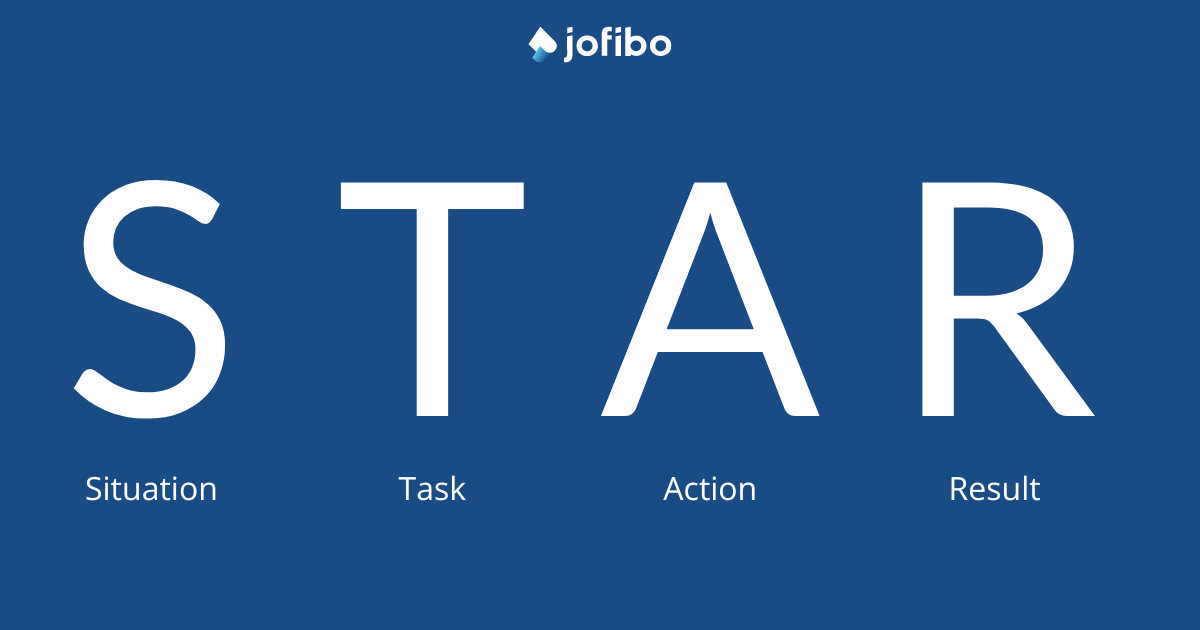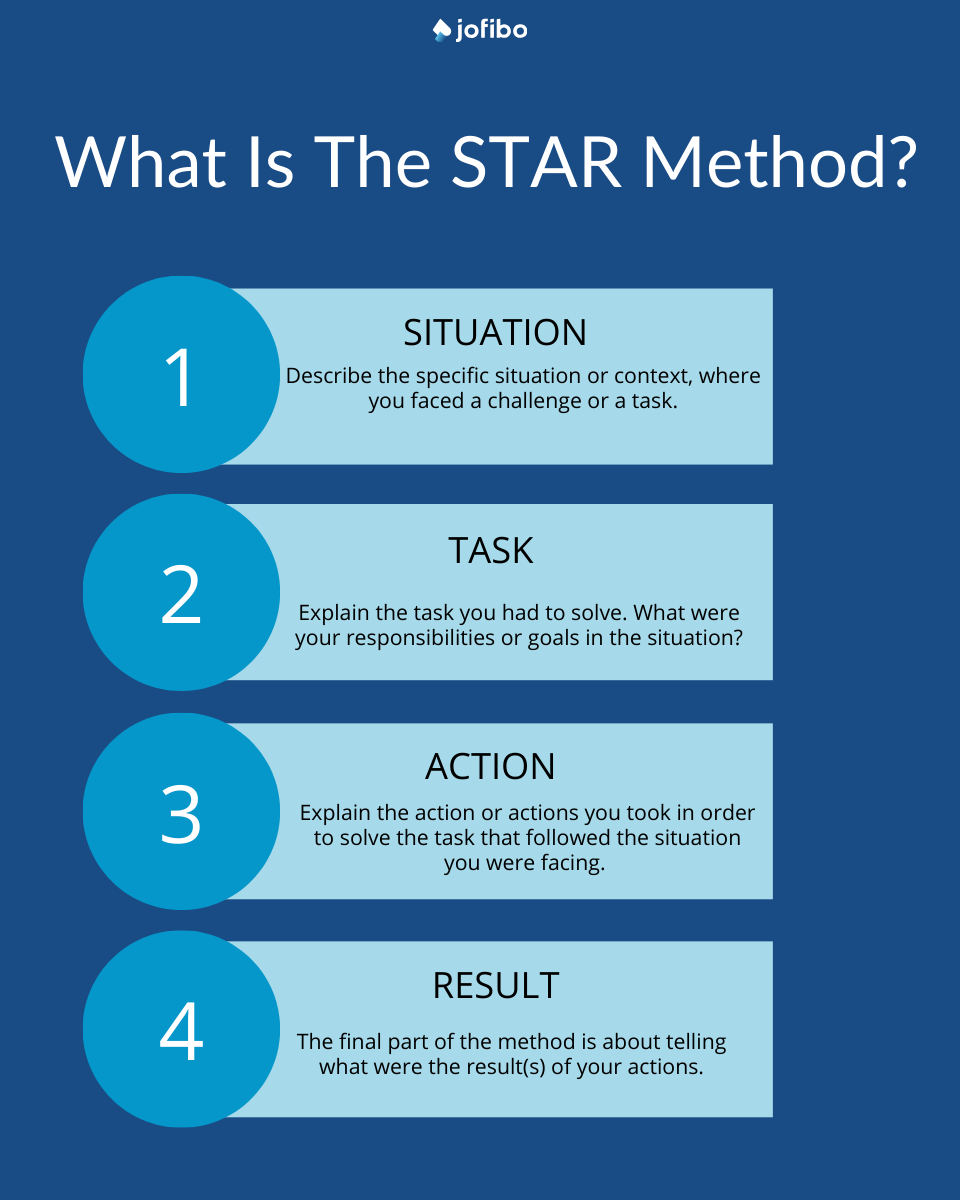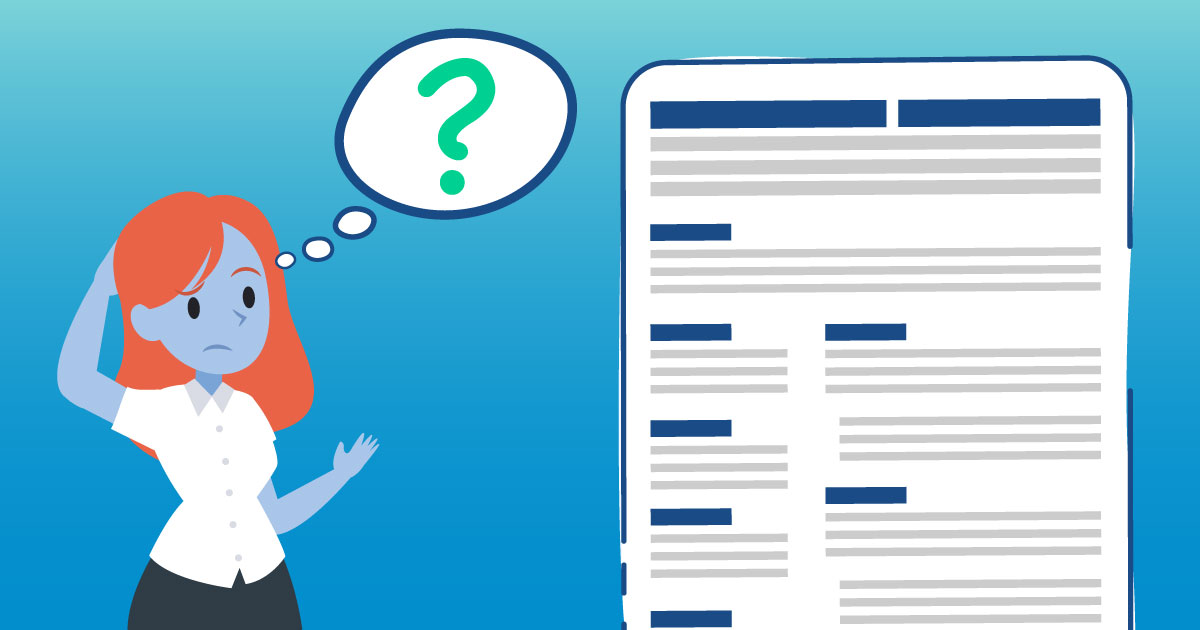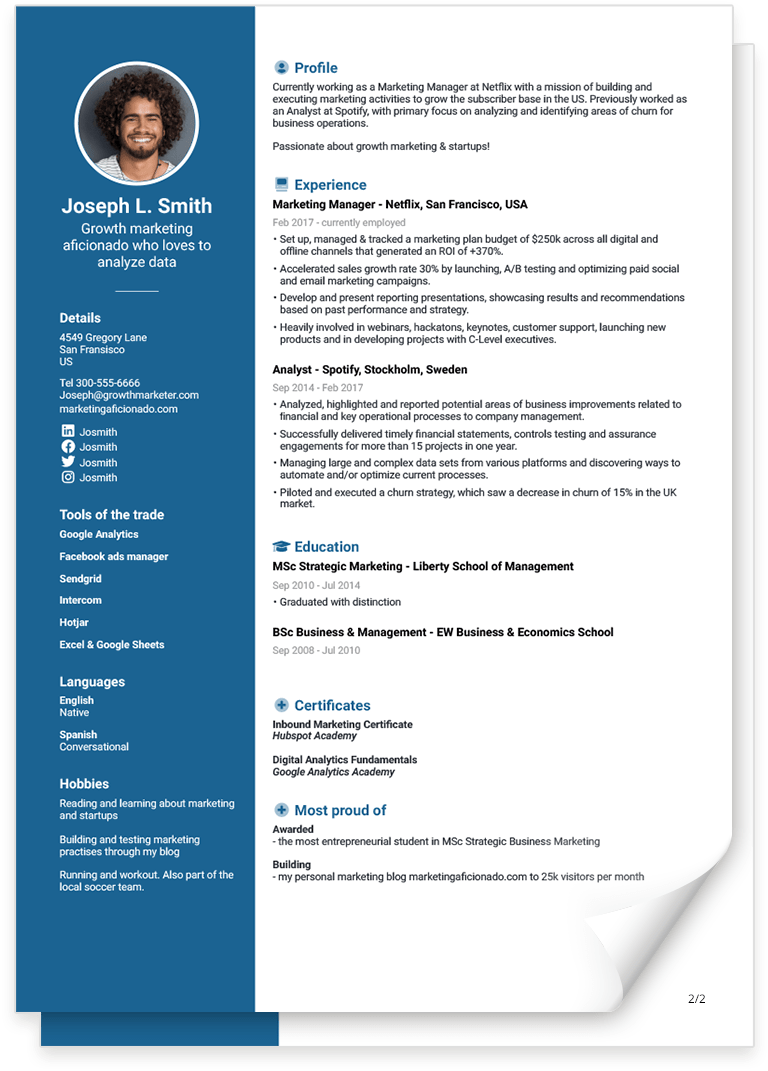Optimize Your Job Search with the STAR Method

As a job seeker, your task is clear. You need to convince a potential employer that you are the right fit for the job you’re applying for. But where do you start? And how do you effectively communicate your strengths and experiences in a way that the employer can understand your value? Don’t worry, there’s help available, and we’ve gathered it all for you right here.
Are you familiar with the STAR method? We’ve mentioned it in other posts on our blog related to preparing for job interviews. In this article, we will delve deeper into the method itself and how you can apply it to your job search.
What exactly is the STAR method?
STAR is an acronym for the words Situation, Task, Action, and Result. The concept represents a structured way of describing your skills and professional experiences, particularly in relation to job searching and interviews.
With this method, you can show how your qualifications benefit the company you’re applying to, rather than just listing them.
Here’s a breakdown of how the STAR method works:
- Situation: Describe the specific situation or context, where you faced a challenge or a task.
- Task: Explain the task you had to solve. What were your responsibilities or goals in the situation?
- Action: Explain the action or actions you took in order to solve the task that followed the situation you were facing.
- Result: The final part of the method is about telling what were the result(s) of your actions.

The last two points, Action and Result, are the most critical elements. This is where you show how you think and solve problems. It’s also where you demonstrate your ability to achieve good results from your efforts.
Here’s an example of how you can use the STAR method to describe a competency:
Situation: In my previous position as a project manager, our team experienced a delay in delivering an important project due to unforeseen technical issues.
Task: My task was to get the project back on track without exceeding the budget or compromising on quality.
Action: I organized a series of meetings with technical experts to identify the issues and find solutions. I restructured the timeline and reallocated resources to prioritize the most critical tasks. I also held regular status meetings with the team to ensure everyone was updated and engaged.
Result: As a result of these actions, the project was completed within the new timeframe and stayed within budget. The quality of the delivery was high, and the client was very satisfied, leading to an extension of the contract with our company.
You can use the STAR method in your resume, cover letter, and to prepare for a job interview. Let’s start with how to use the method in your resume.
How to use the STAR method in your resume
It is very important that your resume is concise while quickly giving the reader a comprehensive overview of your experiences and skills. Therefore, it can be a good idea to use a structured approach to describe your professional experiences. Here, the STAR method is perfect to use.
For each of your three to four most recent positions, you can use the STAR method to describe your most significant achievements. Quantify where possible, but also use alternative results such as learning, acquisition of new skills, and process improvements.
Find three to five achievements from each of your professional experiences. Use the STAR method to turn them into clear sentences that you can use in bullet points to describe the specific experience.
Effective bullet points follow this structure:
1. A verb describing your role in achieving the result
2. What you did
3. What the result was
4. Why this was important
4 tips for using the STAR method effectively in your resume
- Be concise: Resumes should be precise, so keep your STAR examples short. Use bullet points to make them easier to read.
- Be specific: Provide concrete examples and quantify results, if possible.
- Tailor to the job you’re applying for: Adapt your STAR examples to be relevant to the position you’re seeking. Choose examples that highlight the skills and experiences the employer is looking for.
- Avoid repetition: Ensure each STAR example highlights different aspects of your skills and experiences.
Below are some examples of bullet points created with the STAR method:
Example 1:
Led a team comprising customer service, CRM, marketing, IT, legal, and finance through the planning and development of a new customer satisfaction initiative, saving the company $25,000 in monthly expenses.
Example 2:
Collaborated with Samsung’s global ERP department to develop a new sales logistics model, streamlined order fulfillment processes, and implemented a SAP ERP and i2 supply chain management system for the visual displays product division. The effort resulted in a 10% increase in order fulfillment rate, a 30% reduction in account completion time, and a 30% increase in inventory turnover rate.
How to use the STAR method in your cover letter
It is highly recommended to use the STAR method in your cover letter. Here, you have the opportunity to unfold your relevant professional experiences through stories, showcasing how valuable you would be to the company if they hire you. I always recommend using this method when writing a great cover letter.
Here’s how:
- Read the job posting carefully and highlight the experiences and skills required.
- Reflect on your own work life and find examples where you have performed tasks involving these experiences and skills.
- Use the STAR method to structure your cover letter.
When writing your cover letter using the STAR structure, keep this in mind:
Situation should take up about 10%
Task should take up about 10%
Action should take up about 60%
Result should take up about 20%
Example of using the STAR method in a cover letter
In a hypothetical example, an employer is looking for an employee with documented project management experience. Your task is now to show this potential employer that you have experience and can demonstrate results in project management.
To make it easier, I’ve divided the example below into the different elements. When writing your own cover letter, do not include the headings.
Dear Helen,
I am very excited about this opportunity and am confident that my qualifications and experiences make me an ideal candidate for this role. With documented experience in project management and the ability to deliver results, I am sure I can contribute positively to [Company Name].
[Situation]
In my previous position at [Former Employer], our department faced a major challenge in implementing a new software system. The existing system was outdated and inefficient, negatively impacting our productivity.
[Task]
As the project manager, my task was to oversee the entire implementation process of the new system, ensure a smooth transition, and achieve a 20% improvement in efficiency.
[Action]
I began by creating a comprehensive project plan that included clear timelines, milestones, and resource allocation. I assembled a team of key employees from various departments and ensured everyone was aware of their responsibilities.
To ensure the project ran smoothly, I used several project management tools like Trello and Jira to plan and track progress. I also introduced weekly meetings to review status and address any challenges promptly.
I established strong communication channels both internally within the team and externally with vendors. This included regular updates to all stakeholders, ensuring everyone was informed of progress and any changes to the plan.
Furthermore, I focused on risk management by identifying potential risks early in the project and developing contingency plans. This included having backup plans for critical phases of the implementation, allowing us to respond quickly to unforeseen issues.
I also conducted workshops and training sessions for the team to ensure everyone was familiar with the new system before its launch. This included both technical training and process optimization, making the transition to the new system more efficient.
A key part of my approach was to gather feedback continuously. This allowed me to adjust the plan and processes as needed, improving both team morale and the project's success rate.
[Result]
The project was completed within the planned timeframe and under budget. The implementation of the new software system resulted in a 25% reduction in error rate and a 30% improvement in the department's overall efficiency. The success of this project was recognized by the company's management, and I received an internal award for my leadership skills and achieved results.
This experience has strengthened my project management skills, including planning, risk management, team leadership, and communication. I am confident that I can bring these skills to [Company Name] and contribute to your continued success.
I look forward to the opportunity to discuss how my experiences and qualifications can match your needs. I can be reached at [Phone Number] or via email at [Email].
Thank you for your time and consideration.
Sincerely,
John Hanson
How to use the STAR method to prepare for a job interview
If you have progressed far enough in your job search to be invited to a job interview, you’re in the right place. The last part of this article is about interview preparation and how to use the STAR method.
When preparing for a job interview using the STAR method, you base your preparation on behavioral questions. Many interviewers use this type of question during an interview, so it’s a good idea to be prepared for it. The advantage is that you can use examples and successes from your own work life to focus on and map your skills. This approach scores big in a job interview.
Here’s a step-by-step guide to using the STAR method to prepare for a job interview:
1. Identify relevant examples
Review your previous experience and identify specific situations where you demonstrated the skills and competencies required for the job. Focus on examples that showcase your strengths in key areas such as teamwork, problem-solving, project management, communication, and so on.
2. Structure your examples using STAR
For each example you’ve chosen, structure your thoughts using the STAR method:
Situation
Describe the specific situation you were in. Provide enough context for the interviewer to understand the background but keep it short and precise.
- What was the situation?
- What project or task were you working on?
- What challenges or problems were you facing?
Task
Explain what your specific role or task was in this situation.
- What was your responsibility?
- What goals were you supposed to achieve?
Action
Describe the specific actions you took to handle the task or challenge. This is the most detailed part of your response.
- What steps did you take?
- How did you implement your solutions?
- What tools or methods did you use?
Result
Explain the outcomes that were achieved as a result of your actions. Be as specific as possible and use quantitative data if relevant.
- What was the result of your actions?
- How did you contribute to the project’s success?
- What impact did your actions have on the team or company?
3. Practice your responses
Once you’ve structured your examples using the STAR method, it’s important to practice your responses so they come naturally and fluently during the interview. Try telling your stories out loud, either alone or with a friend, and adjust your answers as needed to make them more precise.
Make your job search more efficient with the right tools
There’s no doubt that job searching is hard work, whether it’s by choice or because you have lost your job. Therefore, you might as well use the right tools to make your job search as efficient as possible. That’s why we developed Jofibo. Our resume templates and cover letter templates make it easier for job seekers to create clear resumes and matching cover letters. We frequently hear from recruiters that having a consistent format between application documents makes a noticeable difference in the selection of candidates invited for an interview.
You can create an account on Jofibo for free, and only when you know you can and want to use your documents, is there a small monthly fee. Click the button below and create your first resume today.
![6 Foolproof Ways to Network [examples]](https://jofibostorage.blob.core.windows.net/blog/6-foolproof-ways-to-network.jpg)


